Lately, we’ve been focused on supply chain issues here at The Prepared, and a common recommendation is to invest in resilient hand tools that are durable, easily repaired, and don’t require electricity or fuel.
One old-school tool most people don’t think about much anymore is the scythe, which is a long wooden handle (called a snath) with a curved blade at the end perpendicular to the snath. Most people only know about scythes from images of the Grim Reaper, but for much of agricultural history, the scythe was how farmers cut grass, made hay, and harvested grain.
Is the scythe still a useful tool or is it just an extravagance for LARPers?

Summary:
- It can still be worth keeping your lawn well kept in an emergency because it helps keep ticks and other critters at bay.
- Mowing can also provide material for compost, mulch for the garden, and fodder for livestock.
- There are two styles of scythe: American and European. The European styles are more expensive, but are much better tools.
- In terms of mowing speed, scythes compare favorably to lawnmowers and string trimmers.
- Performed properly, scything isn’t physically demanding. It’s more about the motion than strength or exertion.
- I bought my setup from Scythe Works, which has done a good job of keeping ahead of supply chain issues.
The importance of mowing
When considering long-term SHTF preps, mowing probably isn’t at the top of the list. For many of us, mowing has been reduced to a pointless, repetitive chore, perhaps mandated by a city or HOA.
But there are excellent and practical reasons to mow, like disease control. Let your grass grow tall and in the summer you’ll be inundated with ticks that can carry serious diseases like Lyme and Rocky Mountain Spotted Fever. I let the field adjacent to our house grow wild and the ticks got worse every year. Once I started mowing it, albeit haphazardly, the ticks virtually disappeared.
Another important reason to mow is to prevent forest succession. Leave an area unmowed long enough and it will start turning back to forest, with trees and brambles, and once the process starts, it takes a lot of work to stop or undo it. When I got serious about survival gardening in 2020 I had to first uproot about 20 invasive Trees of Heaven that had started taking over my field, and it’s still a constant fight to keep them cut back.
Mowing provides useful byproducts for resiliency. You can collect the grass clippings to throw onto your compost pile, which you can use to condition soil, fertilizer garden beds, or fill raised bed boxes. Grass clippings alone can make decent compost and they get quite hot when they’re piled up. If you have livestock, like rabbits, you can feed them grass clippings as well. And my scythe has opened up some additional possibilities in that regard that I’ll explain later.
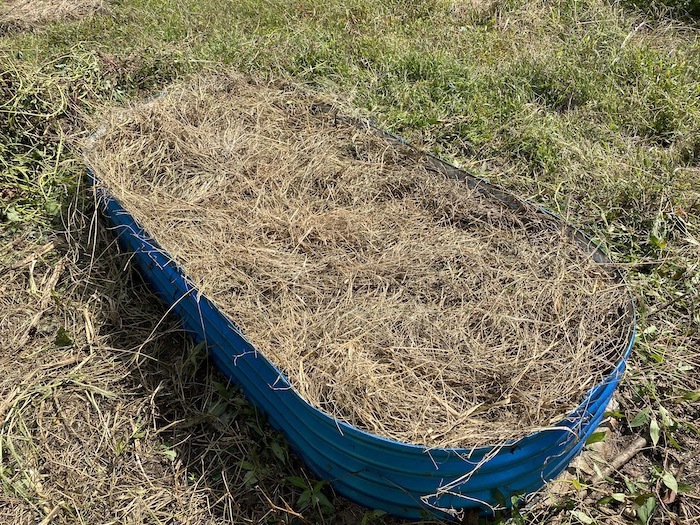
But can you actually mow a typical lawn with a scythe? Yes, you can!
American vs. European scythes
I bought an old, American-style scythe when I moved to our homestead but hadn’t gotten much use out of it. I later learned that European-style scythes were superior tools, and over the summer I became enraptured by videos from the small scything community on Twitter showing them mowing fields and deftly trimming around young trees. Ben Falk’s The Resilient Farm and Homestead further convinced me that investing in a European-style scythe might be a good investment for my farm. (Check out my review of The Resilient Farm and Homestead.)
A lesson on safely using a scythe to manage grass around young trees. Motorized weed havkers and mowers can easily damage young trees.
Use a scythe. 🙏🏼🌳 pic.twitter.com/PI90I6RNX2
— Michael Thomas of Sharon 🌳🌳🌳🐑🐕🏡 (@MichaelTG09) May 15, 2021
American-style scythes are what you tend to find in yard sales and in antique shops. The thick snath is heavy and curved into a subtle S shape with a big metal cap on the end (called a hafting collar) to attach the blade, which is held in place with a metal loop bolt. The handles (called nibs) attach to the snath with toothy metal rings that dig into the wood, and you twist the handle to tighten them. The handles are used facing inward toward the mower. The blade is thick and needs to be sharpened with a file or grinder. The blade also doesn’t usually lay flat on the ground without heating and bending the tang.
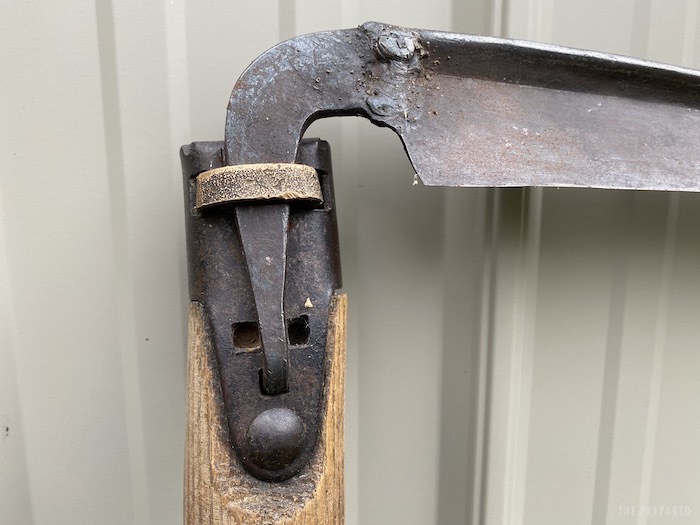
Because American-style snaths are fairly short, you have to bend your knees to use them properly. That, plus the heavy snath and heavy blade make them tiring tools to use.
European-style scythes are very different, though it can be hard to tell in photos, in which both types look like a big stick with a blade sticking out. The European snath is thinner, lighter, and much longer, so you don’t have to bend your knees to use it. The snath is almost entirely straight, except for a small bend at the blade end. Blade attachment is also much different. Instead of a steel cap, there’s simply a hole in the snath where the blade attaches, sometimes protected by a piece of metal. The blade is attached by tension with a ring and a couple of set screws.
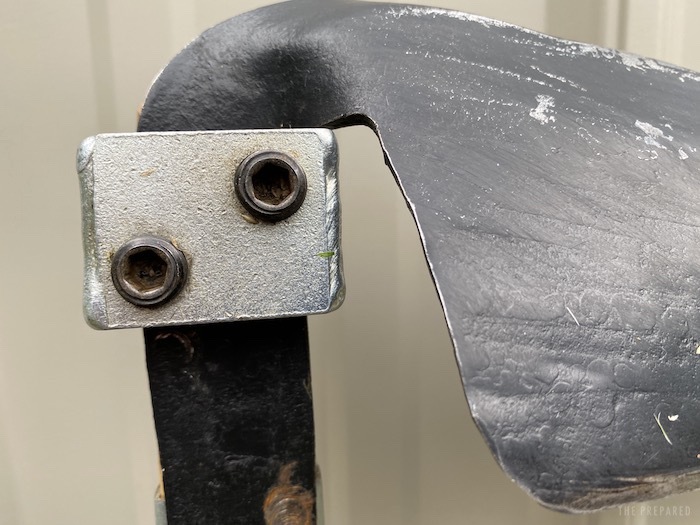
The handles are different, as well. They attach directly to the snath, either with a mortise and tenon joint or with bolts. They face outward instead of inward and the lower handle has an arm to set it off from the snath.
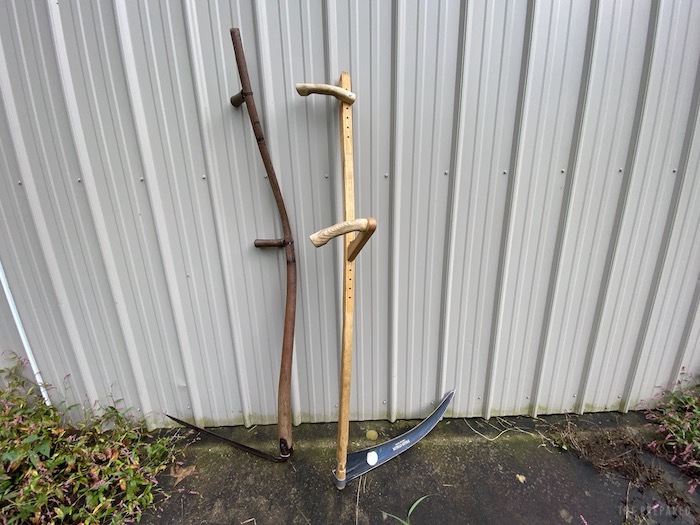
European scythe blades are much different. Instead of being a thick and largely flat piece of steel, they’re thin, light, and tend to have a scoop shape to them.
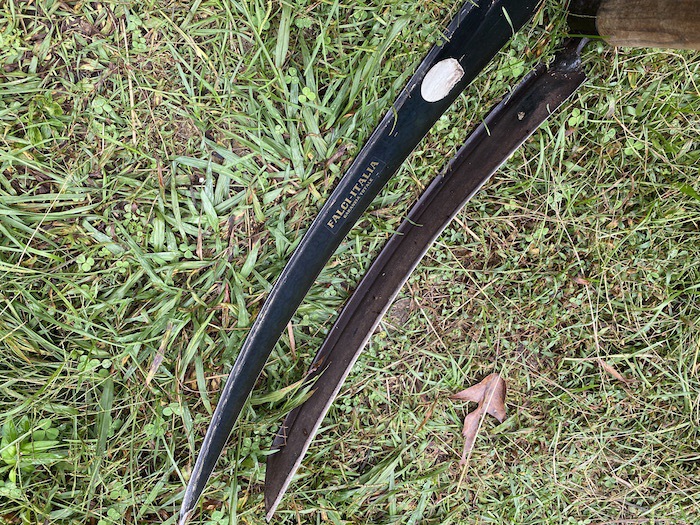
Initial sharpening of European scythe blades is done by hammering the edge, a process called peening, that shapes, thins, and hardens the steel. You then touch up the edge in the field with a stone every few minutes of mowing, though it only takes a few seconds once you get the hang of it.
Scythe peening. pic.twitter.com/w44mWSMjya
— Michael Thomas of Sharon 🌳🌳🌳🐑🐕🏡 (@MichaelTG09) May 23, 2021
Most scything enthusiasts will tell you that the European scythe is the superior tool, and I agree. The European scythe is disconcertingly light and the blade lays nearly flat out of the box. As a result, you get a superior cut with less effort than an American scythe.
That said, American scythes have their fans. Mr. Chickadee, an impressive homesteader in Eastern Kentucky, praises them because he finds them more durable and the blades don’t need to be sharpened as often as European scythes. However, he also heavily modifies his to reduce the weight and improve the lay of the blade.
American scythes have one huge advantage over European scythes: they’re cheap. I bought mine from a retiring homesteader for $25. My European scythe setup from Scythe Works cost about $400, though you can get started for about half of that. If you’re scythe-curious, maybe start with a cheap American scythe to get a feel for it.
Scythe vs. lawnmower
Is a lawnmower a better tool than a scythe? What about string trimmers and brush cutters? Let’s look at the pros and cons of each.
Lawnmower pros:
- Larger riding mowers can mow a big area quickly
- Physically easy to use, unless you’re using a push mower that isn’t self propelled
- Can collect grass automatically for compost or mulch
- Doesn’t require much skill to use, other than maintenance
- Usually provides a clean, consistent cut
Lawnmower cons:
- Good ones are expensive
- Large footprint
- Require gas or electricity to run
- Gas-powered models are loud
- They’re dangerous. Lawnmower injuries send 13 children to the hospital every day.
- Blades can get clogged with tall and/or wet grass
String trimmer / brush cutter pros:
- Can fit into the tightest of spaces
- A brush cutter blade makes quick work out of saplings and brambles
String trimmer / brush cutter cons:
- Needs fuel, usually a special mix of gas and oil
- Noisy
- Tiring to use due to vibrations
- Throw grass and debris everywhere
- Strings need constant adjustment
- Brush cutter blades are super dangerous
Scythe pros:
- Quiet
- Good exercise
- Don’t require fuel or power
- Snaths and blades can last a long time if properly cared for
- Actually work better when the grass is tall or wet
- Cut a larger swath than most push mowers
- Can’t fit into tight spaces as well as string trimmer
- Can’t cut through thick brush and saplings as efficiently as a brush cutter
Scythe cons:
- Require continuous physical effort
- Require skill to maintain and use
- High initial cost
- Less consistent cut than power mowers
- Can’t fit into as tight of spaces as string trimmers
- Potentially dangerous, though most injuries are surface level
- Blades eventually wear down and can be irreparably damaged during mowing if you hit a hard object with enough force
The bottom line: scythes aren’t inferior to mowers and string trimmers, they just have a different set of pros and cons. YouTube is full of videos comparing scythes to more high-tech solutions, with the scythe usually holding its own.
Here’s one of a scythe beating a BCS mower in a race, largely because of operator error:
And here’s a video of a scythe soundly beating a brushcutter in a race:
To be fair, these are highly controlled environments. Nice, tall grass with no rocks or other obstacles. And I’m willing to bet the scythe mowers used long, ultra-sharp competition blades that they wouldn’t use in regular mowing (yes, competition scythe blades are a thing). But these videos demonstrate that a skilled scythe wielder can keep up with gas-powered cutters.
So if the scythe is just as good or better than power mowers and string trimmers, why have scythes been largely supplanted by power mowers and string trimmers?
The obvious answer would be because scything is a lot of work. If you watch a movie where an old-time farmer is scything a field, he’s swinging the scythe like a golf club, high up in the air followed by a powerful swing down. But that’s not how you’re supposed to use a scythe. If your blade is sharp enough, it doesn’t take that much effort.
Sharpening the scythe
Abraham Lincoln said, “Give me six hours to chop down a tree and I will spend the first four sharpening the axe.” How well you sharpen the blade determines how hard you work in the field.
That starts with peening the edge. Traditionally, this is done with a hammer and a special small anvil set into the ground or a stump, which takes a great deal of skill to use correctly. These days you can buy a special peening jig, which is a heavy, round chunk of metal with a metal post on top. You drill a hole in a stump, tap in the jig, and then place a metal cap over the post.
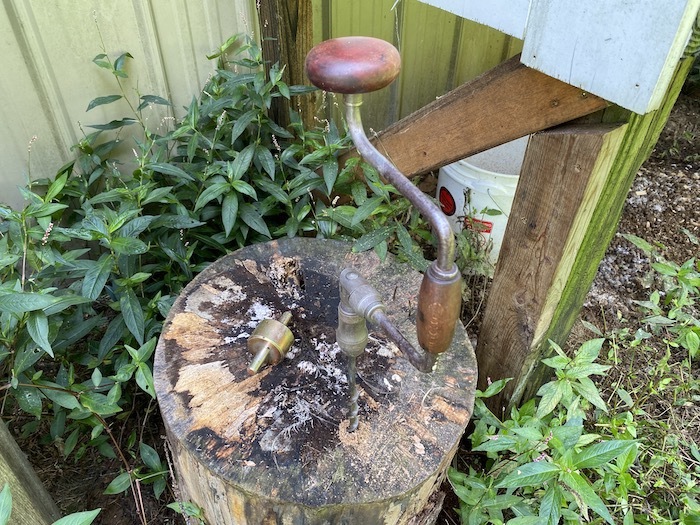
You place the edge of the blade between the jig and the cap and tap on the cap with a hammer, slowly moving the blade along as you go.
There are two caps. The first one you should use is marked with a single line. That cap draws out the steel and sets the edge. The second cap, marked with two lines, flattens the edge. You repeat this process over and over until the blade is sufficiently thin and sharp.
Then you hone the edge of the blade with a long stone soaked in water to produce a razor-sharp edge. You use the narrow face of the stone to hone, using the rib of the blade (the thick part at the top) as a guide, drawing the stone straight down along the edge, moving over a bit, and drawing it down again. With a little practice, honing takes only a few seconds.
That honing should create a burr along the back edge of the blade. You can feel for the rough edge, or with enough light you might even be able to see it. Some mowers keep the burr while others using a gentle swiping motion with the stone to knock it off. The scythe blade is a single bevel, so you only want to sharpen one side.
European scythes need to be sharpened regularly since the fine edge is easily dulled. Mowers carry their stones into the field in special belt holders half full of water, which protects the stone and keeps it lubricated. Traditionally, those holders were made of cow horns, but they’re available in plastic or metal.
If you’re intimidated by the thought of sharpening, check out our sharpening course to become an expert in sharpening blades, which is not just a great preparedness skill, but a great life skill. However, I’ve found scythe blades to be one of the easier things to sharpen. There’s only a single bevel and the peening jig does most of the work. And it’s very easy to tell if the blade is sharp enough.
Fitting
Just as important as sharpening the blade is ensuring that the snath is properly fitted to your body. When you’re repeating the same motion hundreds of times, ergonomics is key.
With the snath on your right side, you want the lower handle by your hand, so you can easily grasp it without reaching it. You want the upper handle up into your armpit.
American snaths are one-size-fits-all, so you simply move the handles to the right places and adjust your stance accordingly.
With a European scythe, you want to be able to hold it and comfortably mow close to the ground without bending or stooping, and without any strain. For that reason, they’re made to order, so when you purchase one, you need to send your height, the measurement between the bottom of your foot and the top of your hip bone, and possibly the length of your arm from your elbow to the tip of your middle finger (called a cubit).
How the heck do you find the top of your hip bone? A chiropractor showed me: rotate your right foot out and back in repeatedly while feeling around your hip with your fingertips. You will feel the bone rotate in your hip, and it’s easy to feel where the top is.
Mowing with the scythe
Once the scythe is fitted to you and properly sharp, you’re ready to mow. You don’t swing the scythe like Jon Daly with a nine iron after two belts of bourbon. Rather, you want to keep the blade as close to the ground as possible. Ideally, with the rib of the blade on the ground at all times. This way you’re not having to lift the blade continually.
I say ideally because my lawn is uneven so I often find myself keeping the blade a bit off ground to avoid plunging the tip into the ground or a tree root. The less you lift the blade, the more efficiently you can mow.
Second, you should use your arms as little as possible. The main motion isn’t in your shoulders but your hips. It helps to hold the scythe kind of loosely so you’re not tempted to swing it with your shoulders. Instead, rotate your hips outward, bringing the scythe with you, and then twist inward, letting the scythe follow along. If you have to engage your arms, do so with your left hand, drawing it back toward your left back pocket. You should feel the burn in your abs and not in your shoulders. If your arms or shoulders are getting tired, you need to adjust your technique.
(Jim Kovaleski is a wealth of scything knowledge and feeds his gardens with a scythe. He’s all over YouTube but doesn’t have his own channel. This video is a great introduction to using a European scythe.)
Mowing this way, with a light European-style scythe isn’t tiring at all. Instead, it’s quite relaxing once you get the hang of it. At first, I found the footwork portion difficult, but I eventually learned to swing, shuffle both feet forward, and swing again. After a while, the motion became natural.
Of course, there are times you need to engage your arms, like when trimming around trees. If your blade is sharp enough, you can simply put the rib of the blade up against the trunk and pull it back to cut the grass.
Another tricky part is figuring out the mowing pattern. Ideally, you stay in a straight line and throw the grass into a straight line, called a windrow. That works well in a tall hayfield but is trickier in a yard. Sometimes I have no choice but to break the pattern, either due to obstacles or the grass laying in such a way that the blade doesn’t cut it easily.
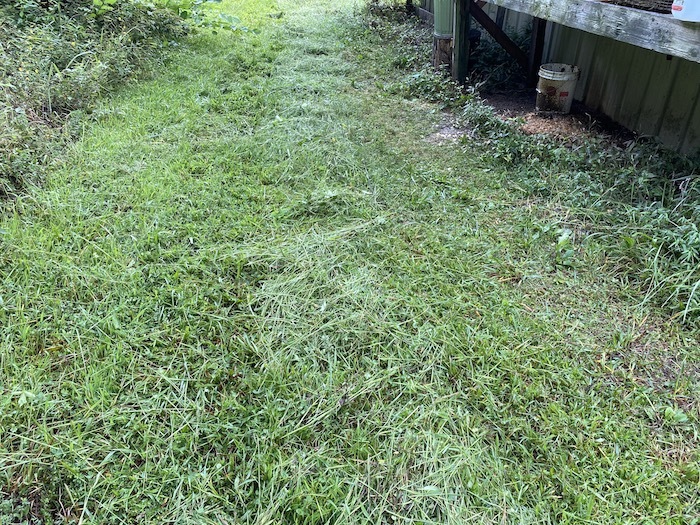
Scythe repair and maintenance
Compared to gasoline engines, scythes are pretty low maintenance. The blade has to be honed regularly, but that becomes almost reflexive once you get used to it. The blade has to be peened every so often, after about 15 hours of use.
As for the snath, you should coat it in something to protect it from water. Alexander Vido from Scythe Works recommends a mixture of boiled linseed oil and turpentine, so that’s what I use. I brush the dirt off the scythe, brush on a light coat of the mixture, and then wipe off the excess with a rag. I set it in the sun for a couple of hours to soak in and dry, then wipe off the rest with a rag and put it away. The trick with oiling any sort of wood is to use multiple light coats. The old adage is once a day for a week, then once a week for a month, and then once a month for a year. I’m not that strict, but the idea is the same.
However, you should not oil the handles themselves, since the oil can irritate your skin. I do oil the wooden piece that connects the lower handle to the snath, though. The handles themselves will absorb oil from your skin, so applying additional oil isn’t necessary.
Another important thing to do after mowing wet grass is to loosen or remove the blade so the wood isn’t damaged as it swells with moisture. I usually just remove the blade after I’m done.
Otherwise, the snath doesn’t need much maintenance. I recently tried to trim a barbed wire fence row and the brambles and barbed wire scratched up the snath (I’ll use the brush cutter for that job). I just cleaned off the snath and oiled it down to protect the scratched pieces, and it’s good to go again.
Grass blades are particularly light and thin, so it’s easy to damage the edge if it hits a rock or other hard obstacle. I did that just a couple of days after receiving my scythe. Thankfully, the repair is simple: file the chipped bit to even it out, peen the blade again, and hone it. Since the steel is so thin, it doesn’t take much filing to smooth it out.
Is the scythe still relevant?
Let’s return to the question I posed above. Why, after hundreds or thousands of years, was the scythe abandoned for power tools? I’ve been mowing my yard and field with a scythe for a few weeks now, and for my small plot, I find it more efficient than my Cub Cadet push mower, as it cuts a much larger swath. And it does so without all the noise and fumes. I can easily talk to my family as I mow with the scythe.
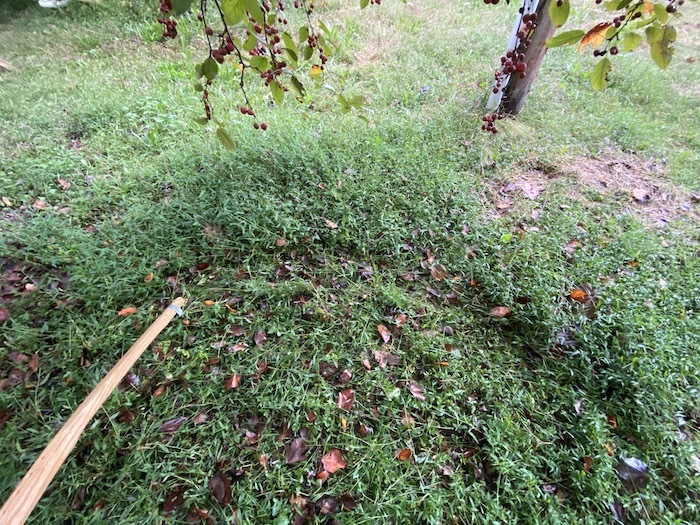
The best part is the scythe doesn’t clog like the push mower. I can mow early in the morning, before it gets hot, even with the dew on the ground. And I can mow when I want. I don’t feel compelled to go mow to keep the grass short enough to keep the mower happy.
I have an odd property layout with a tiny yard, a small field, and a much larger field. I can’t justify a big, expensive zero-turn mower and the push mower doesn’t cut it for the larger areas. For me, the scythe is the perfect tool, combined with my string trimmer and brush cutter attachment for tight spots.
For enormous fields, a tractor is no doubt more efficient, but most people don’t have huge fields.
I suspect the main reason scything is no longer mainstream isn’t physical effort but mental effort. It takes thought and skill to peen, hone, and swing the blade. I find myself constantly making mental calculations. “Is the blade sharp enough? Is the lay flat enough? Am I moving correctly? Am I going to hit that tree?”
Scything takes constant thought and calculation. By comparison, the physical labor is easy, and the tightness in my abs welcome. A power mower takes very little thought if it’s running correctly. A child can crank one up and take off cutting.
And now the power mower has become entrenched in our society. In many communities, you face ostracization or even financial penalties for not keeping your lawn looking like a golf course, and if that’s where you live, a scythe probably isn’t for you.
But I live in the country and no one cares. I’ve found the scythe actually reduces my workload, since I don’t have to cut as often to keep the mower happy, plus I can mow any time I like, even in the rain. And it opens new possibilities. Since I can cleanly cut tall grass into hay, I have an extra source of food for my rabbits, mulch for my garden, and bedding for my chickens. I’m going to experiment with turning part of my lawn into a hayfield and try my hand at building an outdoor hay rack.
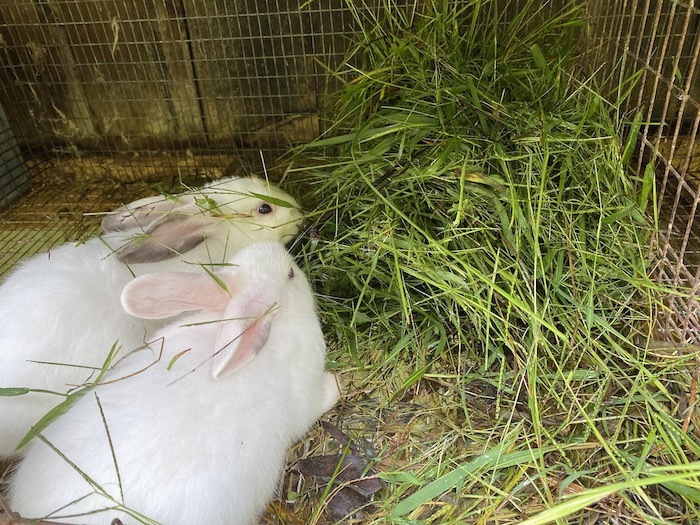
My scythe wasn’t cheap, but I’ve quickly found it to be one of the best self-sufficiency investments I’ve made.
How to begin your journey
First, learn all you can about scything. I’ve linked to many helpful videos through this article. I also highly recommend The Scythe Book, which is the classic treatise on scything. It’s actually two books in one. The first part was written by David Tresemer and the second was added by Peter Vido years later. What’s funny is much of Vido’s section contradicts or rebukes Tresemer, which just goes to show how personal scything is. There isn’t a “wrong” way to do it, as long as you’re comfortable and efficient.
Peter’s brother Alexander also hosts a free scything book by Peter and the Vido family on the Scythe Works website. I recommend reading the books once before you buy a scythe outfit and again after you have a little hands-on experience. For instance, while reading it over to research this article, I realized I’ve been attaching my blade all wrong!
Once you’re ready to take the plunge, there are three main suppliers of European scythes in North America to choose from:
- Scythe Supply out of Perry, Maine
- Scythe Works, out of Victoria, British Columbia
- One Scythe Revolution out of Minnesota
The blades all come from a handful of European companies, like Falci and Fux. The key differences are the snaths and the bundles offered, called outfits.
Scythe Supply is probably the most popular, thanks to their reasonably priced outfits that contain everything you need for $230, including The Scythe Book. However, they’ve been struck by supply chain issues and Ben Falk complained in The Resilient Farm and Homestead that their snaths don’t hold up well.
I purchased my own outfit from Alexander Vido at Scythe Works, which was recommended by Falk. The snaths are strong and also easily adjustable, unlike the Scythe Supply snaths. I purchased the #01a “All-Purpose Outfit”, along with the standard peening kit — which includes a peening jig, natural stone, synthetic stone, and a stone holder. I later added a heavy duty #2001 Falci blade to my order after breaking the blade on my American scythe.
Ideally, you want a few different blades, both for backups, and for different purposes. Long, thin hay blades are great for big, well-tempered fields, but are fragile and not for beginners. Short, heavy bush blades are good for thick brush and saplings. Ditch blades are somewhat in between.
I’ve found that the 65cm Falci blade that came with my outfit is good for most tasks. It’s thin, light, and cuts well, but holds up to abuse. I haven’t gotten as much use out of the heavier Falci blade, but I’m glad to have it when mowing rougher terrain.
Some complain about Vido’s blade selection since he carries old-stock blades, but that’s proven to be a boon as supply chain issues have hampered Scythe Supply in recent months. You might have to peen and hone them before your first cut, but you need to learn to do that anyway.
It’s also a good idea to get some spare parts. I ordered a second set of set screws (Scythe Works offers spares, Scythe Supply does not). An extra attachment ring wouldn’t be a bad idea, either. A blade cover is recommended for transport, but Scythe Works doesn’t sell them and Scythe Supply is usually out. I might cut the legs off some old jeans and sew one end up as a solution.
Your scythe outfit also comes with a wrench to tighten the set screws. Scythe Supply uses a square bit, which I’d prefer since I could easily forge one. Scythe Works takes a 6mm Allen wrench. Whichever type of wrench you need, I recommend stocking up on them. You should carry it into the field to tighten the blade whenever you hone it, but they’re easy to lose. I picked up 25 6mm Allen keys from eBay for $25.
It took a couple of months to receive my outfit from Scythe Supply, due to supply chain issues and the fact that I ordered during the busy summer season. But Alexander was good to call me whenever I emailed him with questions. All in all, I’d recommend Scythe Works.
I don’t know much about One Scythe Revolution. I’ve heard good things about their snaths, but I find their website confusing.
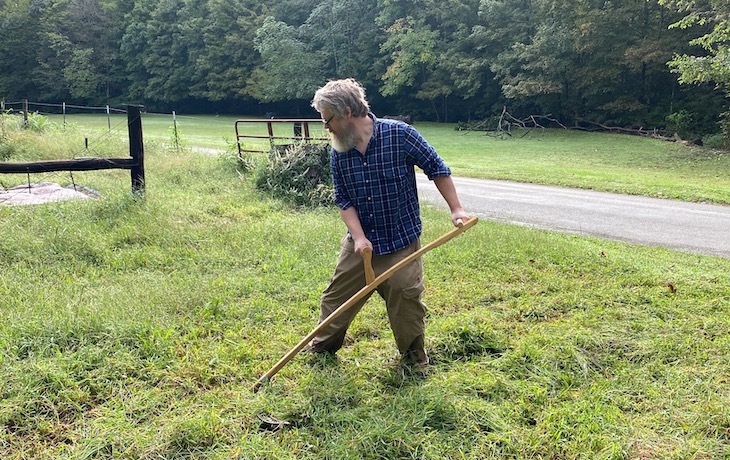
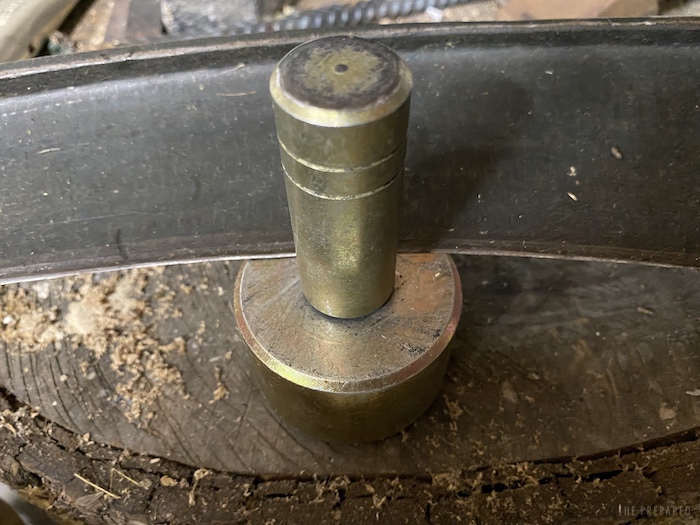
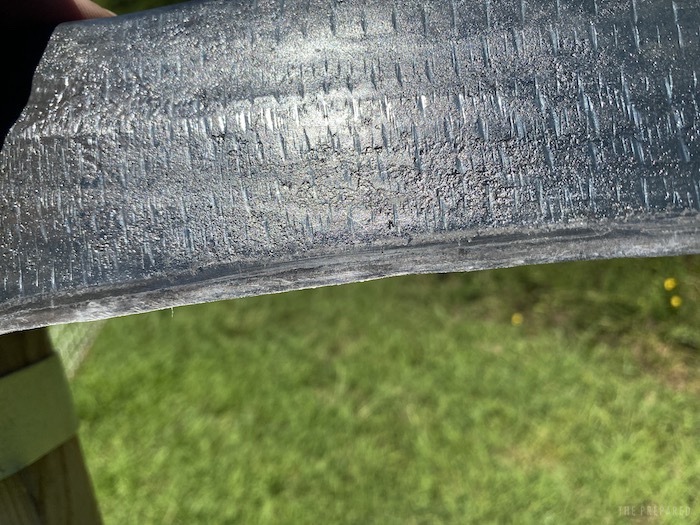
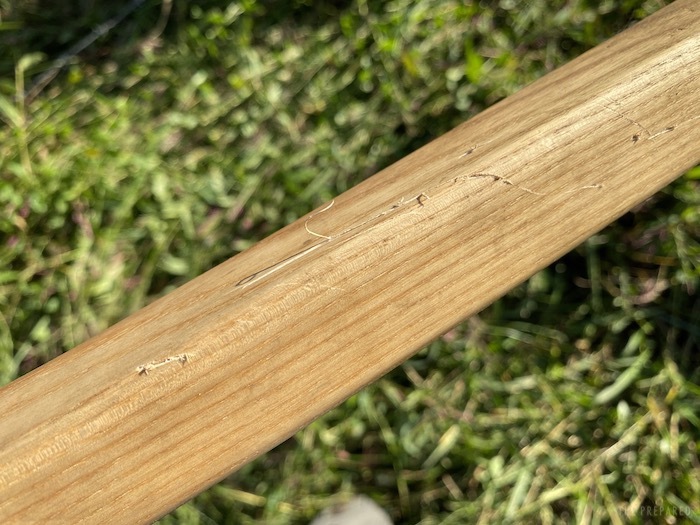
You are reporting the comment """ by on